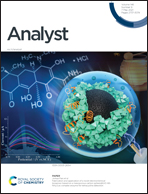An efficient localized catalytic hairpin assembly-based DNA nanomachine for miRNA-21 imaging in living cells†
Abstract
As an enzyme-free isothermal amplification strategy, catalytic hairpin assembly (CHA) is a very promising method for cell imaging. However, the practical application of CHA on intracellular miRNA imaging is limited by slow kinetics, insufficient amplification efficiency and strong interference in living cells. Herein, a localized catalytic hairpin assembly-based DNA nanomachine (LCHA nanomachine) was developed for the rapid, efficient and reliable fluorescence resonance energy transformation (FRET) imaging of miRNA-21 in living cells. The nanomachine was simply constructed by a one-step self-assembly process of a stator strand, a pair of hairpin probes from CHA and an AS1411 aptamer. Benefiting from the spatial-confinement effect, a pair of hairpin probes with high collision frequency was rapidly and efficiently assembled using miRNA-21 as the catalyst on a stator strand in every nanomachine. Compared with the free-CHA nanomachine, the LCHA nanomachine shortened the reaction time by 4.5-fold for reaching a plateau and significant improved the sensitivity by 7.6-fold for miRNA-21 detection in vitro. Importantly, the nanomachine was successfully applied for miRNA-21 imaging in living cells. With the assistance of an AS1411 aptamer and stator strand, the pair of hairpin probes with the ratio of 1 : 1 synchronously transported into a co-site of the cytoplasm, which ensures efficient imaging of trace miRNA-21. The signal output of the ratio of 6-carboxy-fluorescein (FAM) to tetramethyl rhodamine (TAMRA) intensities guaranteed reliability through avoiding the interference from different amounts of the nanomachine that enters into cells. Notably, the nanomachine can distinguish the miRNA-21 expression level in different kinds of cancer cells. By virtue of the advantages of simplicity, efficiency and reliability, the proposed strategy provides a powerful method for exploring the functions of miRNA and diagnosis of disease.



 Please wait while we load your content...
Please wait while we load your content...